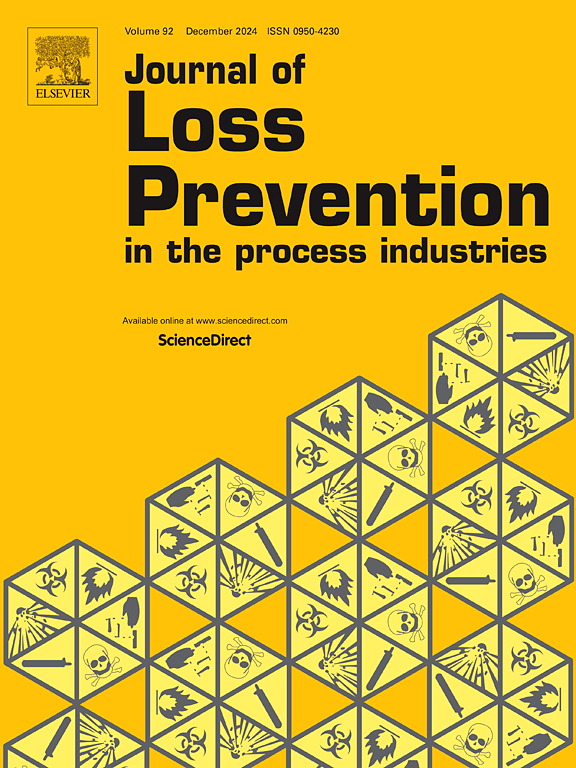Acid-base synergetic effect and thermal risk assessment on homogeneous catalytic production of γ-valerolactone with formic acid
IF 3.6
3区 工程技术
Q2 ENGINEERING, CHEMICAL
Journal of Loss Prevention in The Process Industries
Pub Date : 2025-03-13
DOI:10.1016/j.jlp.2025.105636
引用次数: 0
Abstract
Sustainable and renewable energy plays a key role in coping with the global energy crisis and increasing demand for development. Biomass valorization is regarded as a potential way to substitute the fossil raw materials in various fields such as electricity, fuel, chemicals, pharmaceuticals, etc. Among the numerous chemicals derived from biomass, γ-valerolactone (GVL) is identified to be an important platform chemical with wide applications. Hydrogenation of levulinic acid (LA) with formic acid (FA) as hydrogen donor for GVL production attracts great attention from the principle of green chemistry. Compared to the enormous efforts on catalyst design, few studies focus on the safety issues of this hydrogenation process, such as thermal runaway risk. Aiming to fill this gap, hydrogenation of LA with FA catalyzed by synthesized homogeneous catalyst Ru-TsDPEN was chosen as a typical efficient process for the production of GVL. In particular, solvent effect and acid-base synergetic effect by adjusting acid-base loading were investigated for process optimization and further calorimetry study. Apparent pH was measured to indicate the strength of acidity and alkalinity of the reaction mixture. Thermal stability of chemicals and thermal risk assessment were performed by differential scanning calorimetry and accelerated rate calorimeter Phi-Tec II, respectively. The results showed significant acid-base synergetic effect on the desired catalytic system and thermal risk was medium under the optimized condition, which needs specific safety measures for loss prevention. Suggestions for inherently safer chemical process for GVL production with FA as hydrogen donor were proposed.
甲酸均相催化合成γ-戊内酯的酸碱协同效应及热风险评价
可持续和可再生能源在应对全球能源危机和日益增长的发展需求方面发挥着关键作用。生物质发电被认为是在电力、燃料、化工、医药等领域替代化石原料的一种潜在途径。在生物质衍生的众多化学物质中,γ-戊内酯(GVL)被认为是一种重要的平台化学物质,具有广泛的应用前景。以甲酸(FA)为供氢体的乙酰丙酸(LA)加氢生产GVL的研究受到绿色化学原理的广泛关注。相对于在催化剂设计上的巨大努力,很少有研究关注该加氢过程的安全性问题,如热失控风险。为了填补这一空白,选择合成的Ru-TsDPEN均相催化剂催化FA加氢LA作为生产GVL的典型高效工艺。通过调整酸碱负荷,考察了溶剂效应和酸碱协同效应,为工艺优化和进一步的量热研究提供了依据。测定表观pH值,表示反应混合物的酸碱度强弱。采用差示扫描量热仪和加速量热仪分别对化学药品进行热稳定性和热风险评估。结果表明,在优化条件下,酸碱对催化体系的协同效应显著,热风险中等,需要采取特定的安全措施来防止损失。提出了以FA为供氢剂生产GVL的固有安全的化学工艺建议。
本文章由计算机程序翻译,如有差异,请以英文原文为准。
求助全文
约1分钟内获得全文
求助全文
来源期刊
CiteScore
7.20
自引率
14.30%
发文量
226
审稿时长
52 days
期刊介绍:
The broad scope of the journal is process safety. Process safety is defined as the prevention and mitigation of process-related injuries and damage arising from process incidents involving fire, explosion and toxic release. Such undesired events occur in the process industries during the use, storage, manufacture, handling, and transportation of highly hazardous chemicals.

 求助内容:
求助内容: 应助结果提醒方式:
应助结果提醒方式:


